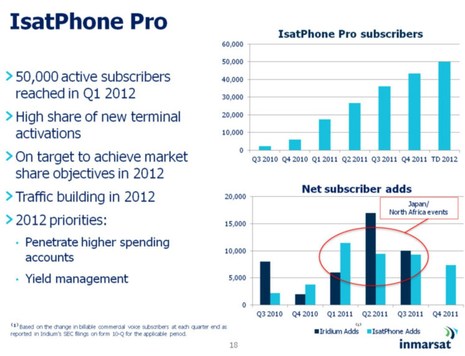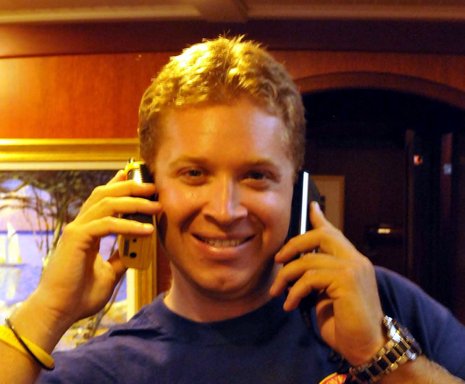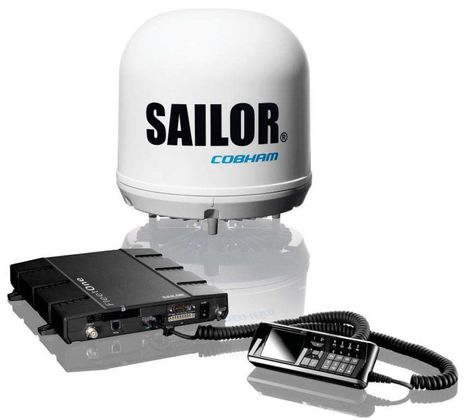Skipper (FB) 150, & a Panbot gets into the biz
Some of us got confused last week when Inmarsat introduced its tiny but fast Fleet Broadband 150 Internet & voice service in Miami. While Inmarsat boasted about “sub $5,000” terminal hardware, KVH said it couldn’t price its TracPhone 150 yet, and a source told me he’d seen a Sailor price list that put its FB150 hardware at over $5,000 wholesale. What we missed was the $4,995 retail FB150 terminal that’s coming from new-to-retail Addvalue Communications. Fortunately, Ronald Hiemann — who sometimes comments here as “Seajet” (his company) or as “Bremer Speck” (his boat) — was able to fill me in on the Wideye Skipper 150. His story begins thusly: “Once upon a time, there was a sailor who wanted Internet access at sea on his sailboat…”
Ronald, you see, was just looking for a good way to replace his troubled Globalstar phone/email system for when he joins the Marion Bermuda Race this June. Well, he was the first end user to contact Addvalue about the Skipper 150, and one thing led to another: Ronald is going to test a prototype unit in the race, and plans to become a Skipper 150 dealer when the units start shipping in July. He says that the antenna and BDU (below decks unit) were developed under an Inmarsat contract and function the exact same way the Thrane & Thrane gear does. And he reports that Addvalue has plenty of experience with sat com technology and that they plan to set up U.S. distribution centers and a simple overnight replacement program in case there are gear problems. I look forward to communicating via Inmarsat with Ronald during the race.
Meanwhile, after watching Visions of Joanna exit Block Island Sound via AIS early Saturday morning, I’ve been emailing with them as they work their way toward Cartegna, Columbia, and eventually New Zealand. You can follow them, too, via their blog, but note that the YotReps widget isn’t working right…just click on the “enlarge” link. They don’t have all the kinks worked out of the Iridium OpenPort up on one spreader, either, and have been using Globalstar for email. “I have not yet gotten Openport to allow a connection via
X-Gate and don’t have any other pop based e-mail clients set up so the
only option would be webmail and that would add up the MB’s quickly” Gram reports, but adds “We have used it for voice a couple of times and the quality is
EXCELLENT (a touch better than Globalstar in voice quality and no lag
with either).”
It’s very cool that VOJ’s other lower spreader is all wired for a test KVH TracPhone FB150 that will go up there when they reach Panama (hopefully). Gram will have lots of time to compare the two services when they head across the Pacific. Between Gram and Ronald — and who knows what Dan will test next — Panbo is going to benefit from a lot of real world Panbot testing this season. And, heck, any day now I may stop yanking old cables out of Gizmo and putting new ones in 😉















Pretty expensive data service for personal (mortal) use. Certainly it would costly to spend several hours per day on it.
Any real likelihood of the cost for “high speed” (up to 150 KBS) coming down?
I want to thank Panbo and Ronald Hiemann for acknowledging the Addvalue produced Skipper 150 FleetBroadband terminal. This is one “Once upon a time…” story that is actually true. Not only true, but driven by the sheer determination of Ronald Hiemann to get his hands on what was only an Inmarsat press release 7 ½ months ago about an idea whose time had come – the FleetBroadband FB150. In the interest of full transparency here, I should disclose that I am the VP of Maritime Solutions for Addvalue Communications Pte Ltd., and the one whose inbox was overrun by emails from a strong willed, single-minded sailor named Ronald who was determined to have a product on his boat come June, which was nothing more than a concept at that time. Needless to say, Ronald won the test of wills and as a result we are thrilled to support Ronald and his boat the “Bremer Speck”. What’s more, I have since been informed by Ronald that he intends to represent the Skipper 150 to his colleagues and fellow yachtsmen – so I guess I will be following Ronald’s lead for sometime to come.
I do want to take just a few lines here to clear up any confusion over the real pricing which, as those of you that travel the world will understand, was based on a little character known as a currency sign, yes the original figure mentioned was 5,000 – but that was US$5,000 for the Skipper 150 and €5,000 euros for the Thrane & Thrane Sailor 150. Actually, as it has now been officially announced, the Skipper 150 has a list price of US$4,995 and the Sailor’s actual published list price is €5,650 euros (or about US$7669). That said, I am sure the Sailor will actually have a street price around US$6,500 +/-. I can not speak for the KVH FB150 – but it should follow the Sailor pretty closely.
As for the airtime costs of the Inmarsat FB150 service, the final pricing is not yet released by Inmarsat. I have seen some comments on this site that look to me to be pretty close to what I expect, but I must also agree with the many comments that FleetBroadband pricing can be very confusing. I can only promise the readers here that as soon as it is out I will give you all the best, simplest and most objective explanation of it that I can (I have been doing this for twenty years – but that doesn’t mean I won’t have to go back to school to figure it out).
SG – The price is not yet official from Inmarsat, however, typically, it is the equipment price that comes down over time and not the airtime price. That said, the saving grace here maybe your choice of airtime provider who will be more likely to put a more “mortal” face on it by providing very creative “pay-as-you-go” and “pre-paid” airtime plans. Look at these options closely and compare them wisely and you may find some real deals there.
Hi Ben,
I am following your blog since quite a while – and I like the sound information I get from your articles and it’s comments.
Coming to the Fleet 150: We used the Nera Fleet 33 for offshore and trans-ocean racing on a 48-foot sailing yacht. Even though the reliabilty was excellent, the power consumption was not. In no way we were able to keep the system on for stand-by of the batteries. I don’t see any improvement to the new Fleet 150 – Addvalue still states a power consumtion of “max. 100 Watt” – I would love to know the average stand-by power – the pointing of the antenna will still drain substantial power.
Hopefully Globalstar will have the money to pay their 40 new Alcatel satellites. In 2007 I crossed the Atlantic on a Swan45 with two Globalstar Modems on board and we even managed to administrate our website using this little, marvelous units. When the 12V batteries were flat, I hooked them to the 7,2V Lithium battery of my Digicam – still worked like a charm 🙂
For those who may be interested to follow the misadventures of s/v “Bremer Speck”, log on to my blog http://bremerspeck.blogspot.com/
Cheers,
Ronald
For Ben and chriggel,
I want to thank chriggle for his comment on power consumption concerns. Because of it, I went back to our engineers (please remember I am with Addvalue) to get some answers AND, hopefully, some solutions. Here is what I know so far: to keep the antenna pointed and “locked” onto the satellite while in non-active “receive mode” requires about 48 watts of power. Not as much as the 100 watts used when transmitting but I imagine it is still a lot when you are trying to run on batteries as much as possible.
Then I sent chriggel’s comments to our “what if” engineers to see if they could offer any solutions, here is the gist of what I received from them:
We can provide two different options, depending on the preference of the users and whether or not they can live with the necessary “wakeup” time that may be involved:
1. “Sailing Mode” – this would be for boats equipped with either wind turbine and/or solar panels. In this mode we can reduce power in every area possible but still leave enough to keep the antenna pointed and locked, which means that the user will still be able to receive incoming voice calls, SMS messages and email.
2. “Battery Mode” – this would be for boats running completely on batteries, or ones that choose not to use their wind or solar power for the communications system. In this mode the system would automatically shut down after a specified number of minutes of non-activity, using only a very minimal amount of power to keep an internal system clock running and few other miscellaneous circuits alive. No voice calls, SMS messages or email can be received in this mode! The Captain will then have the option of setting the system to automatically “wakeup” after specified periods of time and checking for messages and voicemail before going back to sleep. While this mode will draw negligible power, the downside is that the user will have to accept that when he or she wants to “wake up” the system, it may take up to two or three minutes or more for the system to find the satellite again and then re-register itself before a call or message can be placed or received.
In either scenario the user has complete control of selecting the preferred mode and can cancel it at any time. We are very interested in hearing from all of the Panbots that share such concerns – the only challenge involved in finding solutions, is in recognizing the problems. Please let me know your thoughts and we will do everything we can.
Thanks, Greg; that’s a terrific response from Addvalue.
Since I also mentioned the latest voyage of VOJ in this entry, I wanted to add that she’s already abeam the southern Bahamas, and sailed a 234 mile day Wed. Smokin’
I’d be interested to know what the power draw and options are regarding her OpenPort system.
I completely agree with chriggel that power consumption is the unspoken third cost of communications equipment (the first two being equipment and usage charges). My personal belief is that the equipment cost is almost irrelevant when compared with the installation cost, usage charges and power consumption, but I continue to be interested in a solution where those costs are acceptable.
MrGregL – This all sounds great, but for the simple minded could you please summarize the expected power consumption over a 24 hour period for both modes, including some assumption about transmit time?
Hello Russ, I appreciate your comments and encourage others to comment. I have passed your comments on to the engineers and should have an answer in a day or two. Transmit time, however, is something we can not consider as it will vary so much with the individual user. Can you give us an idea of how much you would use such a system per day,i.e. how many min. of voice and how much data?
Very cool! I just got off the phone with Ronald Hiemann. He was not calling from his boat just outside Bermuda, unfortunately, but he was using the Skipper 150 from somewhere off Long Island. Bremer Speck got slammed by the Nor’easter that’s also pummelled us for the last few days, and eventually Ronald decided to drop out of the Marion-Bermuda race rather than see what the storm did to the Gulf Stream. Sounds like a wise move.
But the Skipper 150 he’s beta testing, and was instructed to use to the max, seems to working very well. Ronald’s voice sounded quite natural (though there was a satellite delay that took some getting used to) and he was flipping through Panbo pages and downloading an 11Mb file at the same time. He said that they often have two laptops online via WiFi and the user’s are happy with the speed.
Ronald is also using the FB150 to update his blog, which is a good read:
http://bremerspeck.blogspot.com/
and you can see his and other racer tracks here:
http://maps.iboattrack.com/races/2009_marion_bermuda/htdocs/
Anybody receive a new OpenPort Pilot yet? I’m looking to rent one for a long weekend.